Key takeaways:
- Energy rebate programs provide financial incentives for energy-efficient upgrades, showcasing a variety of options from local governments and utility companies.
- Research and comparison of available rebates are crucial to maximize savings and understand eligibility criteria, which can vary significantly by location.
- Preparation of necessary documentation and meticulous organization streamline the application process and reduce anxiety.
- Engagement in follow-ups and utilizing community resources enhance understanding and effectiveness of applying for rebates, leading to greater benefits.
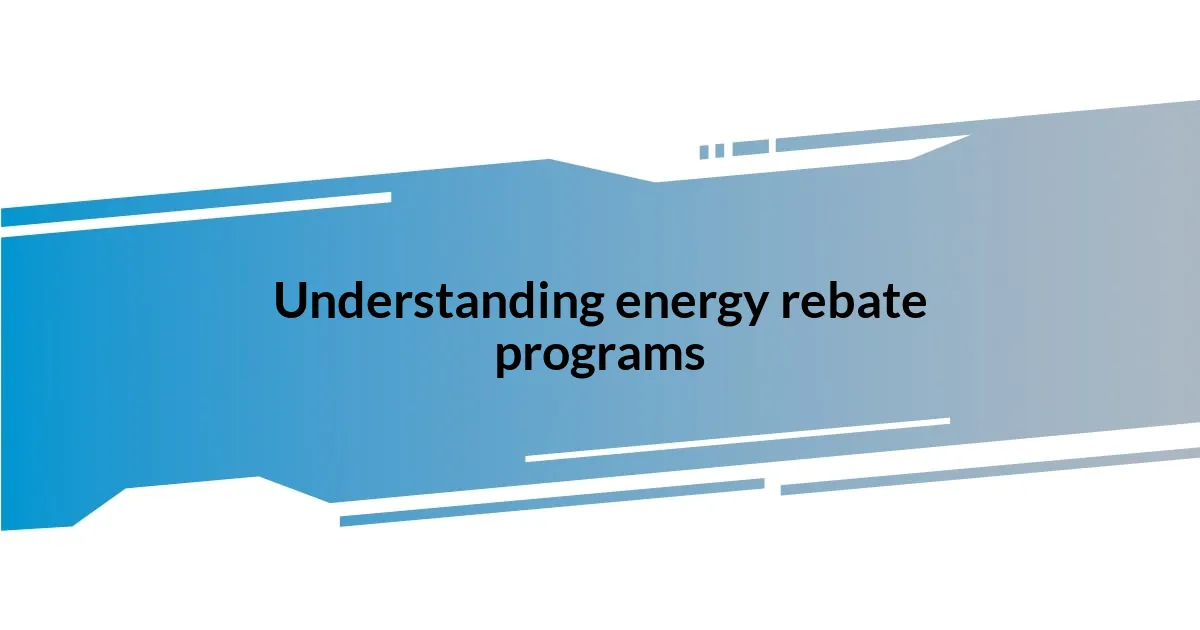
Understanding energy rebate programs
Energy rebate programs can feel overwhelming at first, especially with all the jargon thrown around. I remember when I first stumbled upon these programs; I was skeptical. Would it really be worth my time? But the idea of saving money while contributing to a greener future intrigued me, so I decided to dive deeper.
At their core, these programs are designed to encourage energy-efficient upgrades by offering financial incentives. I once helped a friend navigate the maze of rebates for upgrading her old HVAC system. It seemed daunting, but as we unpacked the requirements together, we discovered that the savings were significant. It was rewarding to see her excitement when we realized she would not only lower her energy bills but also benefit from the rebates offered.
What’s fascinating is the variety in these programs—some are offered by local governments, while others come from utility companies. Have you ever thought about how much you could save if you took the plunge? In my experience, each option has its nuances, so doing some research ahead of time helps you make informed decisions and maximize those savings.
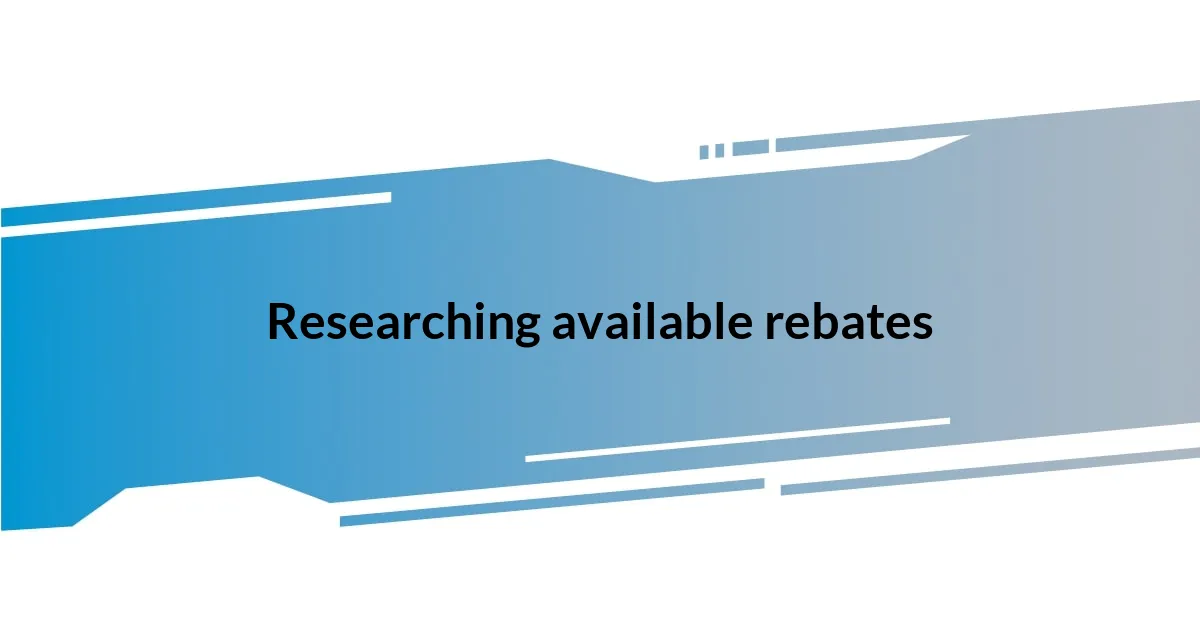
Researching available rebates
When I began my journey into energy rebates, I quickly learned that research is key. I spent countless hours online, looking for programs that were available in my area. It was surprising to find that different states and even municipalities had their own specific incentives. The thrill of discovering a rebate for energy-efficient appliances felt like uncovering hidden treasure. I couldn’t wait to share this information with friends and family!
Exploring available rebates also brought me closer to community resources. Local utility companies often have dedicated rebate programs for their customers. There was one instance where I attended an informational workshop at my local community center. I was amazed at how many people were eager to learn about saving money while helping the environment. Hearing their stories and sharing my research created a sense of camaraderie among us all.
As I continued my research, I realized the importance of comparing available options. There were times I thought I had found the best deal, only to stumble upon something even better. Understanding the eligibility criteria and application processes for each program would ultimately save me time and money. It made the entire experience feel like putting together a puzzle, where each piece fit perfectly when I found the right information.
| Type of Rebate | Source |
|---|---|
| Appliance Upgrade | Local Utility Company |
| Insulation Improvement | State Government |
| Energy-Efficient HVAC | Federal Program |
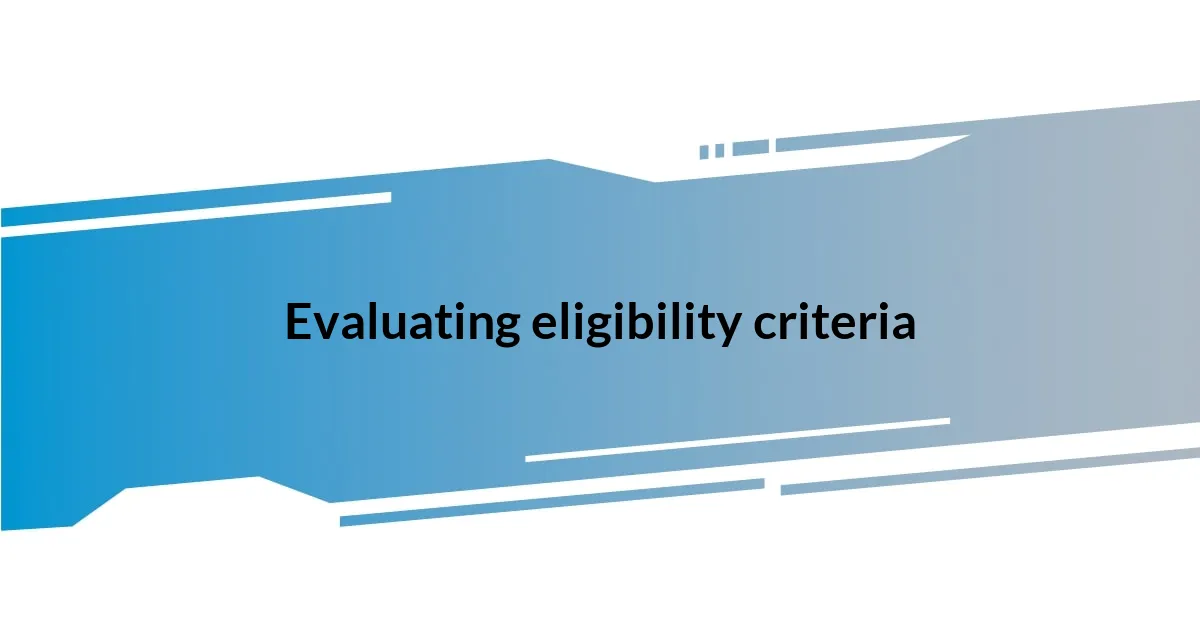
Evaluating eligibility criteria
Evaluating the eligibility criteria for energy rebates can be a bit like navigating a maze, but I found that taking a closer look can pay off tremendously. When I first considered applying for a rebate, I felt overwhelmed by the specifics. However, breaking it down made it easier to understand what I needed. I recall feeling a wave of relief when I checked my home’s energy efficiency rating and realized I was already in the running for several incentives.
Here are some key eligibility criteria to consider:
- Home Age and Type: Some programs are targeted specifically at older homes or specific housing types.
- Income Level: Certain rebates are available only to low- or moderate-income households, which can provide additional savings.
- Upgrades Completed: Rebates often require proof of completed upgrades, so I found it helpful to keep records handy.
- Residency: Many programs are restricted to residents within specific jurisdictions; I learned this the hard way when I initially applied for a program outside my area.
- Equipment Specifications: Ensuring that your appliances meet energy efficiency standards is crucial, as I discovered when I almost missed out on a great rebate for my new refrigerator.
Understanding these criteria opened up a world of possibilities for savings that I never thought possible. It transformed my initial uncertainty into excitement, as I realized I was well on my way to a more energy-efficient home and a lighter budget.
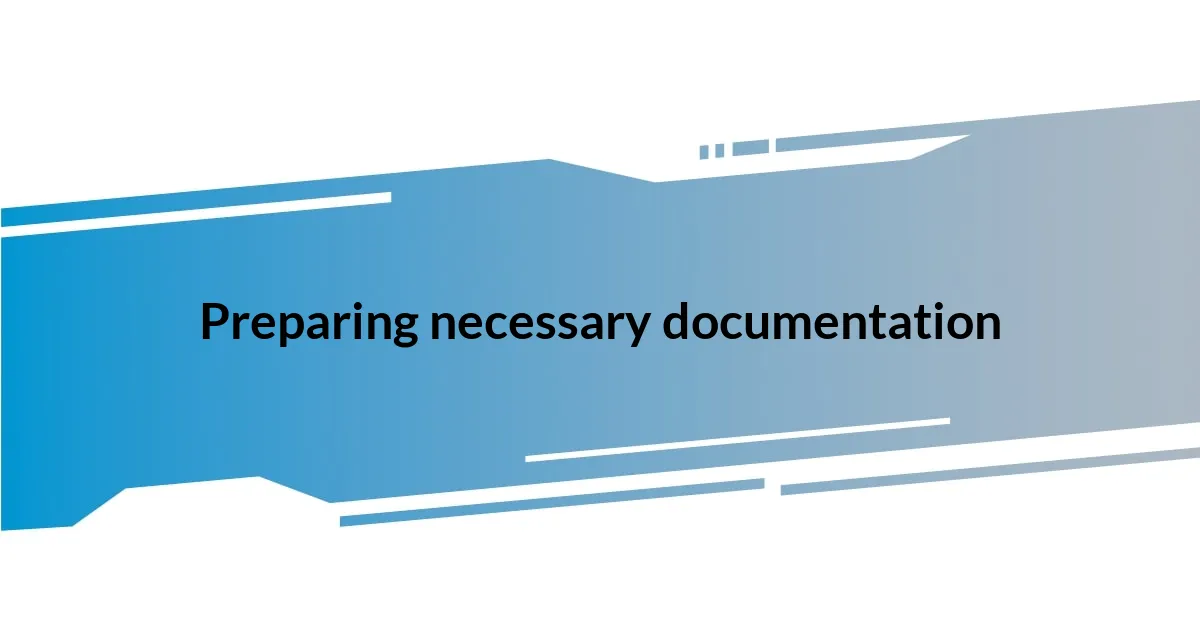
Preparing necessary documentation
Preparing the necessary documentation felt like assembling a treasure map; each piece was vital to reach the ultimate reward. I learned early on to gather my proof of purchase and installation documents ahead of time. The thrill of finding just the right receipt for my new solar panels—or even a simple invoice—was actually a bit exhilarating. Can you imagine the sense of accomplishment when everything fell into place?
Keeping everything organized is essential to avoid last-minute panic. I started a dedicated folder on my computer where I scanned all relevant documents, including energy audits and contractor estimates. Each time I added another piece, I felt more in control of the process. I also developed a checklist that guided me through the submissions. This was not only practical but also a confidence booster—after all, nothing beats the satisfaction of checking off those items one-by-one!
I still remember that moment of realization when I had everything ready: applications, receipts, and photos of the upgrades. It struck me how much easier things became once I prioritized good organization. Having my documents in order not only helped speed up my applications, but it also gave me peace of mind. I could focus on the exciting part—planning how to use my future savings! What could you do with your extra cash? The possibilities seemed endless.
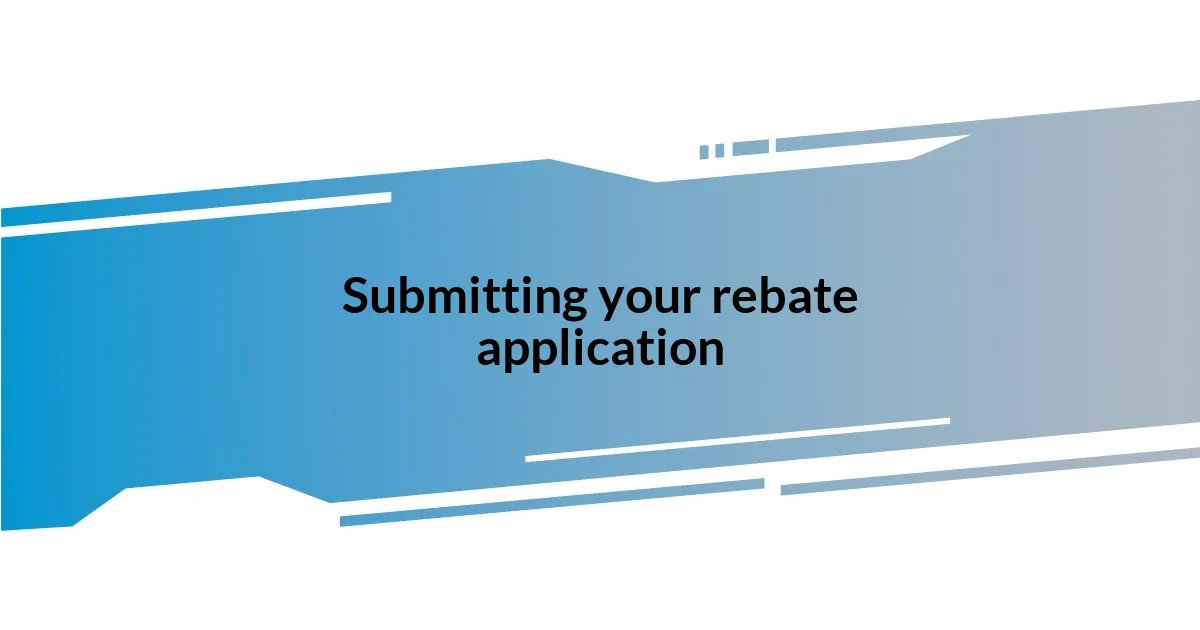
Submitting your rebate application
Submitting the rebate application was, in many ways, the final puzzle piece in the whole process. I remember sitting at my kitchen table, carefully filling out the forms when I suddenly felt the weight of it all. Had I included everything necessary? Would I qualify? It was a mix of anticipation and anxiety, but I focused on clarity and precision to keep that fear at bay.
I quickly realized the importance of double-checking every detail before submission. One small mistake could delay the reward I was aiming for. I found it incredibly helpful to have someone else review my application—sometimes, a fresh pair of eyes catches things you might overlook. Plus, discussing the process with a friend not only calmed my nerves but also provided insights I hadn’t considered, like which supporting documents might enhance my application’s strength. Have you ever felt that rush when you submit something you’ve worked hard on?
After I clicked “submit,” a wave of relief washed over me. I had crossed a tangible finish line! But the waiting game began. To keep myself engaged during the anxious pause, I created a calendar to track any follow-ups or potential responses. This also reminded me that I was taking proactive steps toward a more energy-efficient home, turning my worries into motivation. Did you ever realize that what might start as a daunting task can become an empowering journey?
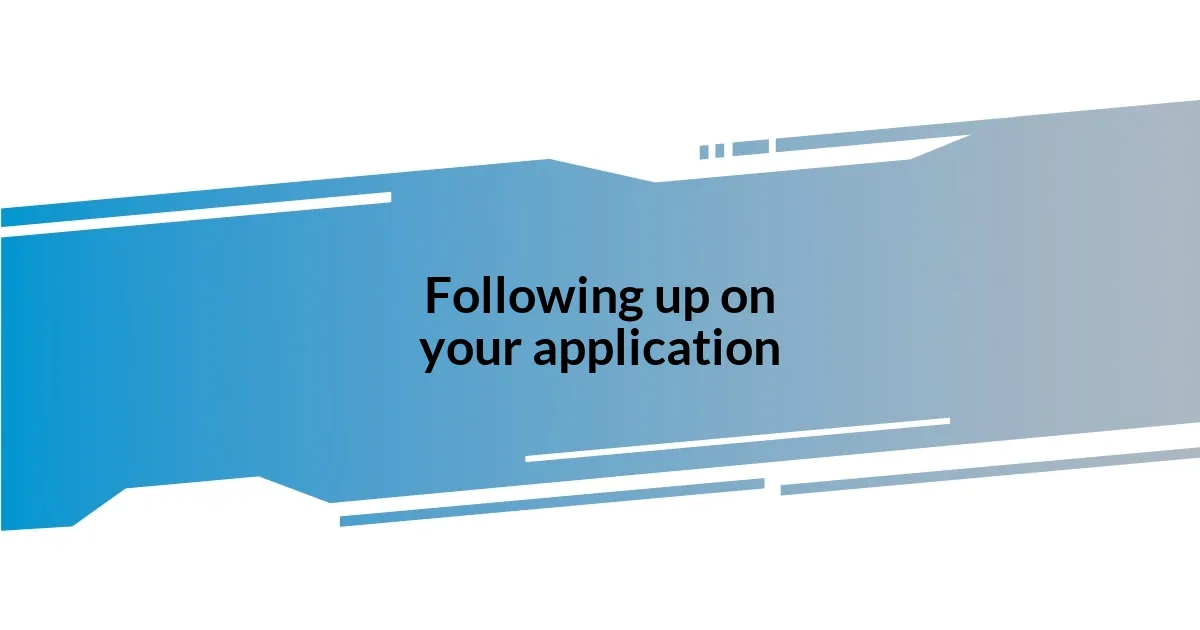
Following up on your application
Following up on my application was a new adventure altogether. After hitting submit, I felt a mix of excitement and impatience. Did you ever find yourself staring at your inbox, refreshing it like a teenager waiting for a text? I made it a point to give my application a reasonable time frame—typically two weeks—before I started checking in, just to ensure I wasn’t being a helicopter applicant.
When the time came, I picked up the phone and called the rebate program hotline. It was a surprisingly involved experience. The representative I spoke with was friendly but brief, which meant I had to be well-prepared with all my details. I felt a little nervous, like I was at a job interview, but I reminded myself that I was advocating for something truly beneficial. Each response I received—from their system checking my application to confirming that everything was in order—felt like a small victory. Did I genuinely understand the timelines and protocols? This clarity significantly eased my mind.
Every follow-up gave me more insights into the process. I discovered that the program had specific timelines for reviews and approvals, something I hadn’t fully grasped before. Knowing that my application was moving through the system made me feel like I was part of something bigger, almost like being on a team working to reduce energy consumption. Engaging with the process this way made each response a building block toward my ultimate goal—those precious energy savings!
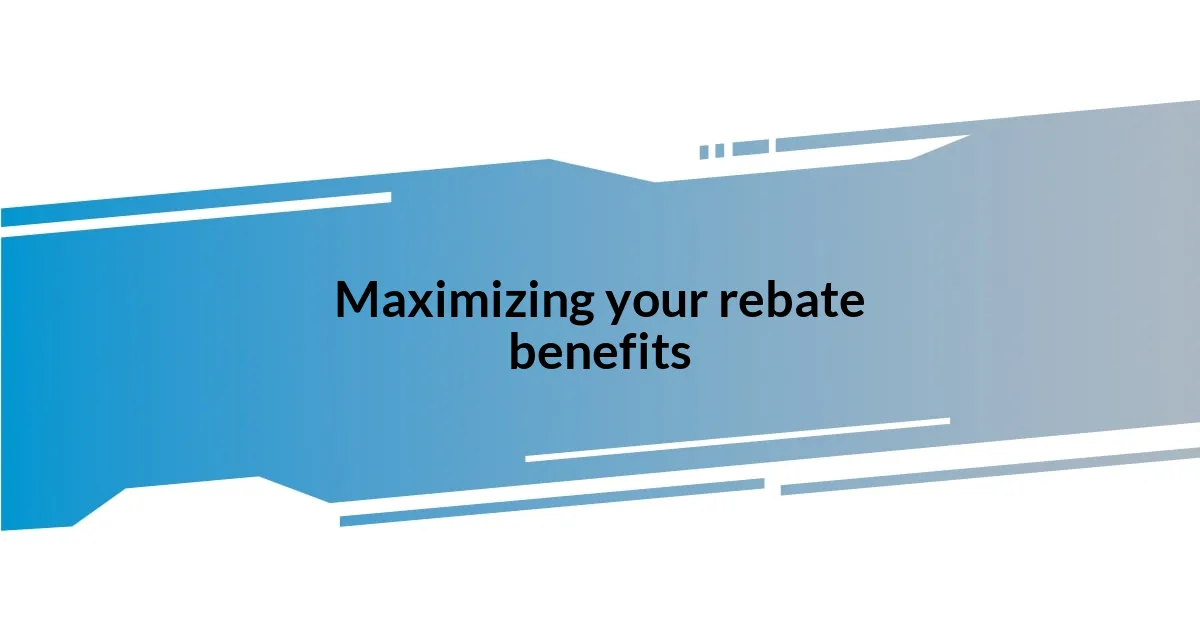
Maximizing your rebate benefits
To truly maximize your rebate benefits, I found it essential to do thorough research on the various programs available. Initially, I was overwhelmed by the options—some rebates were local, while others were state or even federal. Have you ever felt confused by too many choices? I decided to create a comparison chart that outlined eligibility criteria, timelines, and potential savings. This turned my anxiety into strategy, making it simpler for me to select the rebates most aligned with my goals.
Another valuable lesson for me was leveraging community resources, like workshops or webinars. I attended one local seminar on energy efficiency, and it turned into a goldmine of information! The host shared insider tips on maximizing the rebate amounts. Hearing success stories from others ignited my enthusiasm. It’s amazing how shared experiences can illuminate a path forward—what resources have you tapped into that enhanced your understanding?
Finally, keeping meticulous records became crucial. I set up a dedicated folder, both physical and digital, for all related documents. I included receipts, application forms, and correspondence with rebate programs. This organization not only simplified the process but also empowered me. I knew that having everything at my fingertips would be invaluable if any issues arose. Can you remember a time when being prepared made all the difference? It’s that proactive mindset that truly maximized my rebate benefits.